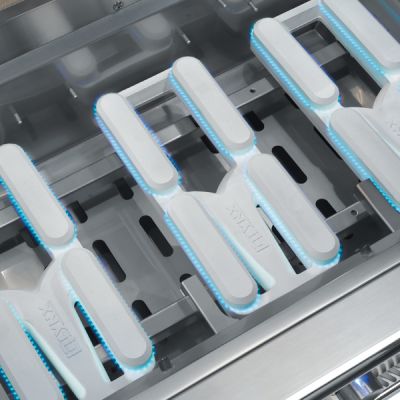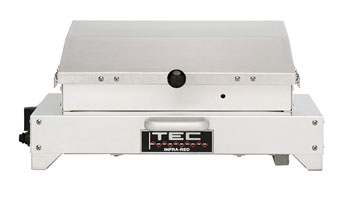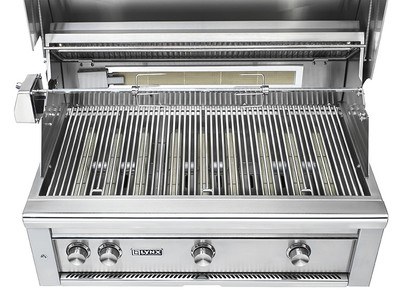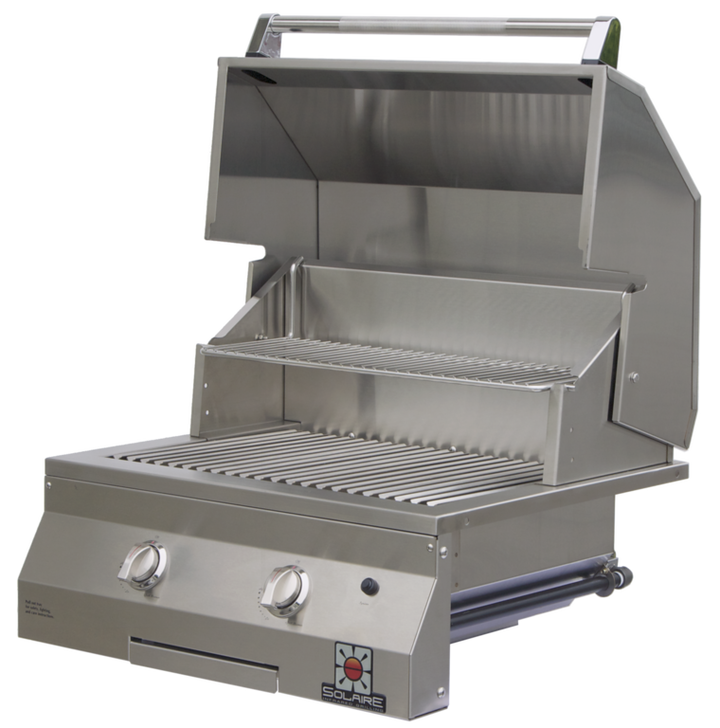What Is an Infrared Grill: Infrared vs Gas Grills
When it comes to outdoor cooking, the debate between infrared grill vs gas grill is a hot topic. While traditional gas grills have been a staple for many, the innovative infrared grills are gaining popularity for their efficiency and quality. If you're wondering how does an infrared grill work and whether it's the right choice for you, this guide will help you compare your options side by side.

This technology is what you find in Steakhouse restaurants. This technology uses radiant energy, not air to cook the food. Eliminating dried out food.
Open flame grill burners produce heat over a 15-20 minute warm up period, radiate that heat through a heat distribution system (ceramic rods, lava rock, etc), to evenly distribute heat the across grilling area. Unfortunately, hot spots occur and a lot of the heat gets redirected downward. This results in circulating hot air that removes the moisture from grilled food causing it to dry out.
What is an Infrared Grill?
Infrared Grills utilize radiant energy, a technology first introduced by TEC Grills in the 1980s, to maximize flavor and heat versus open flame (otherwise known as blue flame or convection) cooking that is traditionally found in grills like Weber. Due to the intense heat, you keep your hood open when grilling on an infrared grill.
Convection grills use 100% hot air when cooking food. This dries out food as it cooks. Infrared grilling eliminates the hot air retaining approx 35% more of its natural juices.
The Infrared Burner utilizes uniform radiant energy that heats the food directly. Infrared technology does not rely on hot circulating air to heat the food. Food cooks faster and retains more juices. Additionally, infrared grills are less prone to flare-ups because the intense heat instantly vaporizes the drippings and returns with favor-enhancing smoke. Many of the finest steak houses use infrared burner systems to prepare their meats.
Advantages of Infrared Grills
Infrared all-sear burner grills are a favorite of grillers everywhere. Here are some of the reasons why you may opt for this grill yourself.
Infrared all-sear burner grills are a favorite of grillers everywhere. Here are some of the reasons why you may opt for this grill yourself:.
- Heats Up Quickly: Infrared grills can heat up in just 2-5 minutes, significantly faster than traditional open flame grills.
- Even Heat Distribution: By reducing reliance on hot air, infrared grills help your food retain up to 35% more moisture, keeping your meats juicy and veggies tender.
- Maintains Moisture: By reducing reliance on hot air, infrared grills help your food retain up to 35% more moisture, keeping your meats juicy and veggies tender.
- Steakhouse Quality: Achieve the tender, juicy steaks of a high-end steakhouse right in your backyard. Many of the finest steakhouses use infrared burner systems to prepare their meats.
- Less Prone to Flare- Ups: The intense heat of your infrared grill instantly vaporizes the drippings and returns with flavor-enhancing smoke. With traditional gas grills, these drippings can drip down to the heating elements and cause dangerous flare ups.
- Uses Less Gas: Infrared grills are more fuel-efficient, reaching high temperatures quicker than open flame grills.
- Self Cleaning: Infrared burners have a self-cleaning ability simply by turning up the heat to high for about five minutes when you are finished grilling. The high heat will vaporize any food residue.
Styles of Infrared Burners
As if the decision of choosing an infrared grill vs a traditional gas grill wasn’t enough, your choices are further split into different infrared grill styles.
When TEC Grills first invented the infrared grill, there was only one option. But then many grill companies jumped on the infrared bandwagon, offering this new technology as an option. Many of these brands use different styles of infrared burners, differentiating themselves from each other.
1. Traditional Ceramic Infrared Burners (Most Common)
Traditional ceramic infrared burners use ceramic plates in a stainless-steel housing with a stainless mesh on top of the burner. The pores in the ceramic plates produce tiny flames that reach temperatures exceeding 1,200 degrees in 3-5 minutes. Cooking Temperatures, in these burners, tend to have a higher temperature, ranging from 600 to over 1,000 degrees. Flare-ups can occur when food drippings drip in the tiny pores of the burners.
Alfresco, Solaire and Twin Eagles are a few of the top brands offering a traditional ceramic infrared burner. The Lynx ProSear 2 Ceramic Infrared Burner is another example, and features a unique trident shape (unlike traditional rectangular burners) that offers a lower cooking temperature range (300 degrees) and a larger searing area.
2. TEC's Radiant Glass Panel System
By now you know that TEC Grills was the founder of infrared grilling technology. That puts them a few steps ahead of other brands when it comes to reinventing the burner system.
Case in point, they invented the radiant glass panel system, which features a durable steel burner, their radiant glass panel, and a cooking grid on top. With this system, there are virtually no flare ups and even better heat distribution. The cooking temperature can get as low as 200 degrees (one of the lowest in the marketplace) to grill super delicate foods.
This technology can be found in the newly introduced Patio FR and the Sterling Patio FR. They are still capable of steakhouse-quality searing, even with the lower temperature range.
Beware of grills that "claim" to have a searing burner when these are just traditional burners. A true Infrared grill has a ceramic top with many honeycomb ports.
Top Infrared Grill Brands:
If you are in the market for an infrared grill, we believe that TEC (the innovators) remains at the top of our list for quality and consistent heat. However, there are a few other high-quality brands worth considering as well.
Also consider :
- TEC Infrared: Known for quality and consistent heat, TEC remains a top choice for infrared grilling.
- Lynx Professional Grills all Trident: Offers precision temperature control with their infrared burners.
- Solaire Infrared Grilling: Know for simple, easy to use grills.
Is an Infrared Grill Worth it?
It’s worth considering getting an infrared grill if you want to avoid the flare-ups and dry food issues associated with the traditional gas grill. However, you are looking at a higher price tag and a bit of a learning curve.
Many people will ask, “Is an infrared grill worth it?” We say it depends. Other grilling experts tend to agree with us.
As more restaurants add infrared grills to their kitchens, many wonder if the decision is based on status versus performance. Thomas Liu, the director of products at a food industry company, told the LA Times, "It's not about performance, but paying extra for a brand, feature or benefit that makes you the hero".
Infrared Grills use less gas, provide the most even temperatures, and heat up super quick! We do not feel they are better, just different. Depends on the types of foods you grill if this is a better method of grilling.
But with that, in our experience, customers either love them or hate them. They are great for quickly searing your food and sealing in juices then transferring your food to an open flame.
How to Buy the Best Infrared Grill for Your Grilling Needs
Consider factors like the number of burners, temperature range, and control, size, quality, brand, durability, price, and portability. Infrared grills are now more accessible, with many brands offering them at competitive prices.
We recommend finding a grill with at least one searing burner. This will help you lock in those delicious juices. Typically, sear units are one temperature, but some brands (like Lynx) offer variable sear options. This allows you to cook less dense foods faster. The temperature typically ranges from 275 to 1,100 degrees.
However, if you are more of a hotdog person than a steak person, you may not need a sear burner.
While infrared grills used to be more expensive than traditional gas grills, there are many brands that are adding them without any additional cost. In particular, an infrared grill will result in restaurant-quality steaks and meats. Friends and family will be flocking to your backyard for some tasty BBQ.
What's the Difference Between Infrared Burners and Traditional Gas Burners?
In short, the difference between infrared burners and traditional gas burners is that infrared burners heat the food directly while traditional gas burners heat the air that then heats the food. This means that infrared grills cook food more quickly than traditional grills. However, this may not be what you want all of the time.
Below we cover how traditional gas burners work so that you can make an informed decision on which grill is best for your grilling needs.
What is an Open Flame in a Gas Grill?

Open Flame is also known as convection or blue flame. It is where the grill gets heated by burners with ports that surround it. The Burner can be stainless or cast iron and have a flame that comes out of each of the ports. The grill needs a heat distribution system (heat plates, briquette trays, etc) to evenly distribute the heat.
This differs in infrared since the infrared burner itself radiates the heat.
One of the benefits of the blue flame burner is better temperature control and the ability to grill on low temperatures.
Styles of Open Flame Burners
- Cast Burners : these burners can be made of brass, stainless steel, or iron. They come in various shapes including the “E” Cast Stainless Burner used in Firemagic Grills, Cast Ceramic as used in the Lynx Grills, and Cast Iron Pipe burners used in many big box store grills.
- Stainless Steel: - Most of the higher- end grills (DCS, Alfresco, Twin Eagles) use U shaped center- fed pipe burners
Meeting in the Middle – Hybrid Grills
Increasing in popularity are Hybrid Grills. These are grills that use both infrared and open flame burners. For example, a hybrid grill may have an infrared burner for fast grilling and then stainless-steel burners for traditional grilling.
There are many different combinations and brands on the market. If you want both of the benefits of infrared grilling and traditional grilling, check out these hybrid options.
- Lynx Professional Series 36 in Built-In Grill with Trident
- Sedona by Lynx L500PSR 30" Built-in Grill w ProSear
- Alfresco ALXE 30" Built-in Grill with Sear Zone
We suggest adding the sear (infrared) burners to larger grills (42” and up) so you do not lose traditional open flame grilling space. Especially in grills like Alfresco and Lynx that do not allow the infrared burner to be changed with a convection burner.
Twin Eagles, Artisan and Delta Heat allow you to interchange the convection burners with infrared and vice versa. They are giving you the widest range of grilling temperatures.
The Best Infrared Grills
TEC Cherokee FR 23" Infrared Portable Grill

This grill provides one-half the grilling surface of our full size two burner models in a small less expensive cabinet that is light enough to carry with you anywhere you go.”
Features:
- Made in the USA
- 192 Square Inch Cooking Surface
- Body made of Brushed Aluminum with Stainless Steel Cooking Grid
- Radiant glass panel prevents flare-ups
- Removable ash tray
- Push button electronic ignition
- Removable inner trim panels for easy cleaning
Lynx 36" All Trident Built In Grill - L36ATR

The Lynx 36" All Trident Built-In Grill uses the exclusive temperature sensors in the grill, along with electro-mechanical gas to control valves that keep temperatures at the perfect level.
Features:
- Made in the USA
- Hot surface ignition system
- Heat stabilizing design
- Temperature gauge
- Removable large-capacity smoker box
- Stainless steel grilling grates
- For Natural Gas Grills you will need a natural gas hose kit sold separately
Solaire AGBQ 27" Basic Built-In All Infrared Grill

The Solaire AGBQ 27" Basic Built-In All Infrared Grill produces food to rival anything you've ever tasted in a fraction of the time you're used to spending.
Features:
- Made in the USA
- Two infrared main burners
- Can Easily Convert Infrared Burner to Convection Burner
- Stainless Steel V-Grilling Grids Enhance Flavor and Reduce Flare-Ups
- Removable Stainless-Steel Warming Rack And Drip Tray
- Commercial Grade Stainless Steel Construction
Also consider Solaire's Portable Grills these grills have a great price with amazing power!
Explore Our Range
Choosing between an infrared and a gas grill comes down to your cooking style, the types of food you grill, and your preference for temperature control and fuel efficiency. Both have their unique advantages, and the right choice will elevate your grilling experience. As with any purchase, it’s important to weigh the pros and cons of all of your options. We recommend giving us a call if you have any questions.
Discover our selection of infrared and gas grills here. For more insights into outdoor cooking, visit our other blog posts here.

